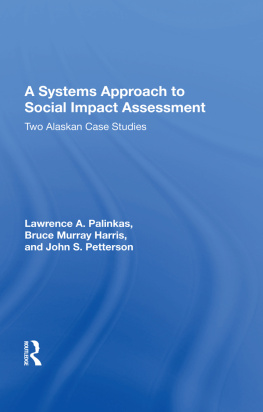Palinkas - Achieving Implementation and Exchange
Here you can read online Palinkas - Achieving Implementation and Exchange full text of the book (entire story) in english for free. Download pdf and epub, get meaning, cover and reviews about this ebook. year: 2018, publisher: Bristol University Press, genre: Home and family. Description of the work, (preface) as well as reviews are available. Best literature library LitArk.com created for fans of good reading and offers a wide selection of genres:
Romance novel
Science fiction
Adventure
Detective
Science
History
Home and family
Prose
Art
Politics
Computer
Non-fiction
Religion
Business
Children
Humor
Choose a favorite category and find really read worthwhile books. Enjoy immersion in the world of imagination, feel the emotions of the characters or learn something new for yourself, make an fascinating discovery.

- Book:Achieving Implementation and Exchange
- Author:
- Publisher:Bristol University Press
- Genre:
- Year:2018
- Rating:5 / 5
- Favourites:Add to favourites
- Your mark:
- 100
- 1
- 2
- 3
- 4
- 5
Achieving Implementation and Exchange: summary, description and annotation
We offer to read an annotation, description, summary or preface (depends on what the author of the book "Achieving Implementation and Exchange" wrote himself). If you haven't found the necessary information about the book — write in the comments, we will try to find it.
Palinkas: author's other books
Who wrote Achieving Implementation and Exchange? Find out the surname, the name of the author of the book and a list of all author's works by series.
Achieving Implementation and Exchange — read online for free the complete book (whole text) full work
Below is the text of the book, divided by pages. System saving the place of the last page read, allows you to conveniently read the book "Achieving Implementation and Exchange" online for free, without having to search again every time where you left off. Put a bookmark, and you can go to the page where you finished reading at any time.
Font size:
Interval:
Bookmark:

| ACS | Administration for Childrens Services (New York City) |
| ADHD | attention deficit/hyperactivity disorder |
| ARC | Availability, Responsiveness and Continuity program |
| ASD | autism spectrum disorders |
| BHS | Behavioral Health Services (San Diego County, California) |
| BPT | behavioral parent training |
| CAF | Computer Assisted Fidelity Environment |
| CAL-OH | the CaliforniaOhio study |
| CASRC | Child and Adolescent Services Research Center |
| CBT | cognitive behavioral therapy |
| CDT | community development team |
| CEI | Cultural Exchange Inventory |
| CFIR | Consolidated Framework for Implementation Research |
| CIMH | California Institute of Mental Health |
| CSAP | Center For Substance Abuse Prevention |
| CSNYC | Child Success New York City |
| CTAC | community technical assistance center |
| CTP | Clinic Treatment Project |
| CWS | Child Welfare Services (San Diego County, California) |
| D&I | dissemination and implementation |
| EBDM | Evidence-Based Decision Making model |
| EBP | evidence-based practice |
| EPIS | Exploration, Preparation, Implementation and Sustainment framework |
| GBG | Good Behavior Game |
| IDEAS | Center for Implementation-Dissemination of Evidence-Based Practices among States |
| IND | individualized implementation |
| KEEP | Keeping Foster Parents Trained and Supported |
| KMb | knowledge mobilization |
| KT | knowledge translation |
| KTE | knowledge transfer and exchange |
| LC | learning collaborative |
| LOCI | leadership and organizational change for implementation |
| MATCH | Modular Approach to Therapy with Children |
| MMT | modular manualized treatment |
| MOST | multiphase optimization strategy |
| MST | Multisystemic Therapy |
| NICE | National Institute for Health and Care Excellence |
| NIDA | National Institute on Drug Abuse |
| NIH | National Institutes of Health |
| NIMH | National Institute of Mental Health |
| NIRN | National Implementation Research Network |
| NPT | normalization process theory |
| OJJDP | Office of Juvenile Justice Delinquency Prevention |
| OMRU | Ottawa Model of Research Use |
| OMH | Office of Mental Health (New York State) |
| OSLC | Oregon Social Learning Center |
| PTC | Parenting Through Change |
| PTSD | posttraumatic stress disorder |
| QI | quality improvement |
| QIC | quality improvement collaborative |
| RCT | randomized controlled trial |
| RE-AIM | reach, effectiveness, adoption, implementation, and maintenance |
| RPPP | researchpracticepolicy partnerships |
| SAMHSA | Substance Abuse and Mental Health Services Administration |
| SIC | Stages of Implementation Completion |
| SIEU | Structured Interview for Evidence Use |
| SMT | standard manualized treatment |
| SMART | sequential multiple assignment randomized implementation trial |
| SOCE | System of Care Evaluation (San Diego County, California) |
| TFCO | Treatment Foster Care Oregon |
| TF-CBT | Trauma Focused Cognitive Behavioral Therapy |
| UC | usual care |
| URE | use of research evidence |
Font size:
Interval:
Bookmark:
Similar books «Achieving Implementation and Exchange»
Look at similar books to Achieving Implementation and Exchange. We have selected literature similar in name and meaning in the hope of providing readers with more options to find new, interesting, not yet read works.
Discussion, reviews of the book Achieving Implementation and Exchange and just readers' own opinions. Leave your comments, write what you think about the work, its meaning or the main characters. Specify what exactly you liked and what you didn't like, and why you think so.











